The Perimeter Tool
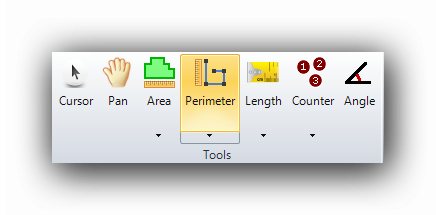
The Perimeter Tool measures a continuous linear dimension on the canvas. Measure with the mouse by clicking with the left button on all the points (usually the corners) on the perimeter to be measured. To release the point entry and end the measurement, click the right mouse button. The Perimeter tool generates results in linear units (linear feet, millimetres, meters, etc.)
Create a New Perimeter

When the Perimeter Tool is selected, a "Create a New Perimeter" window appears to let the user configure the settings of the object or group of objects. In this window, the Name, Color, line Thickness and Slope factor can be set for this object. A "Save as template" checkbox can be checked to save this Perimeter configuration for future use on another page of the plan or on new projects. Click the "OK" button to confirm the settings and start measuring on the canvas.
|
The Tabs When creating a New Perimeter, the window will open on the "Properties" tab. An "Extensions" tab displays the available extensions which will add extra results to the raw measurement taken. A "Comment" tab adds comments to the object or group of objects. These comments can be displayed in the report. The extensions and comments can be added later if they are not configured here. |
|
The Name of the Perimeter object is modifiable to the user's specifications. |
|
The object color Select the object's color with the dropdown menu of by clicking on the "Palette" button. |
|
The segment Thickness The thickness of the drawn line is modifiable with this slider right from the creation of the object group. It is afterwards modifiable in the Properties grid. |
|
The Slope Factor Apply a Slope Factor if needed. For more information about Slope factors with the Perimeter tool, click here. |
|
Save as template Saves an object as a template for future use on another page of the plan or on new projects. To save a template, check the checkbox before clicking the "OK" button. |
Measuring with the Perimeter tool
The pointer for the Perimeter Tool looks like this : 
In the example images, locate the left clicks : and right clicks :
and right clicks :
Method # 1 : Click on the perimeter points
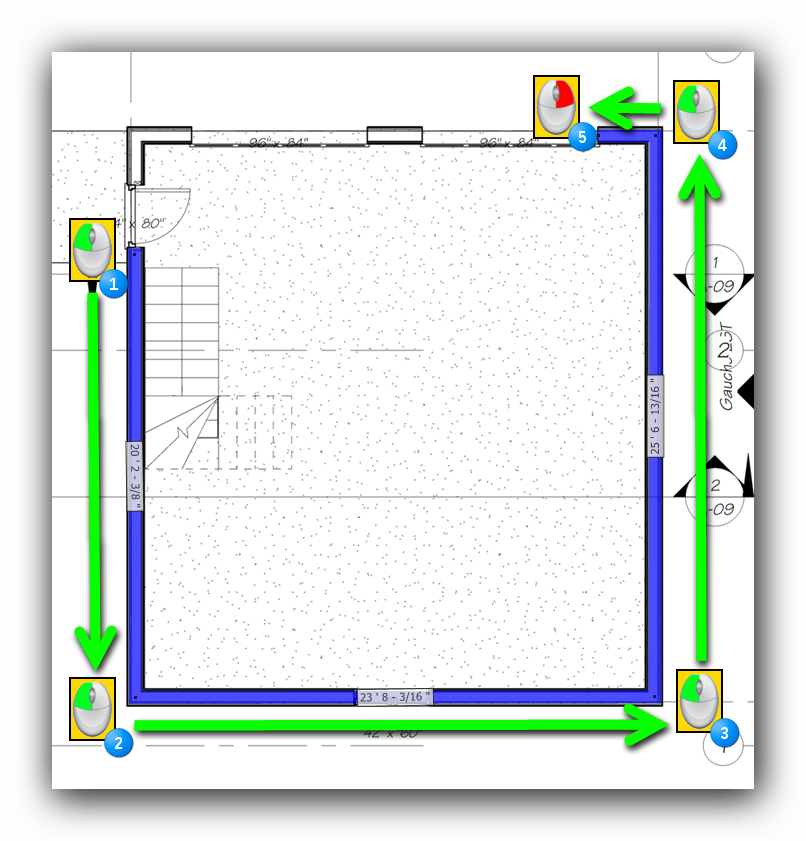
To measure a Perimeter, follow the item to be measured on the canvas. Click with the left mouse button on a point (usually a corner) on the perimeter. Click on the next point in a clockwise or counter clockwise movement with the left mouse button and so on until the entire Perimeter is covered and colored by the tool. To release the tool and stop producing points, click the right mouse button. Each corner of the Perimeter will be represented by a black square (anchor point). The anchor points can be moved to adjust the Perimeter to the exact item to be measured on the canvas. The segments found between the anchor points can also be manipulated. Once the Perimeter is completed, the tool will remain active to draw another Perimeter.
Hint 1 :
Use (Ctrl + Right-click) on the last point of a perimeter to close the shape to the original perimeter point.
Hint 2 :
Use (Ctrl + Shift + Right-click) on the last point of a perimeter to close the shape to the original perimeter point and perform an automatic adjustment of the shape.
Method # 2 : Stretch a rectangular perimeter from a corner to the opposite corner
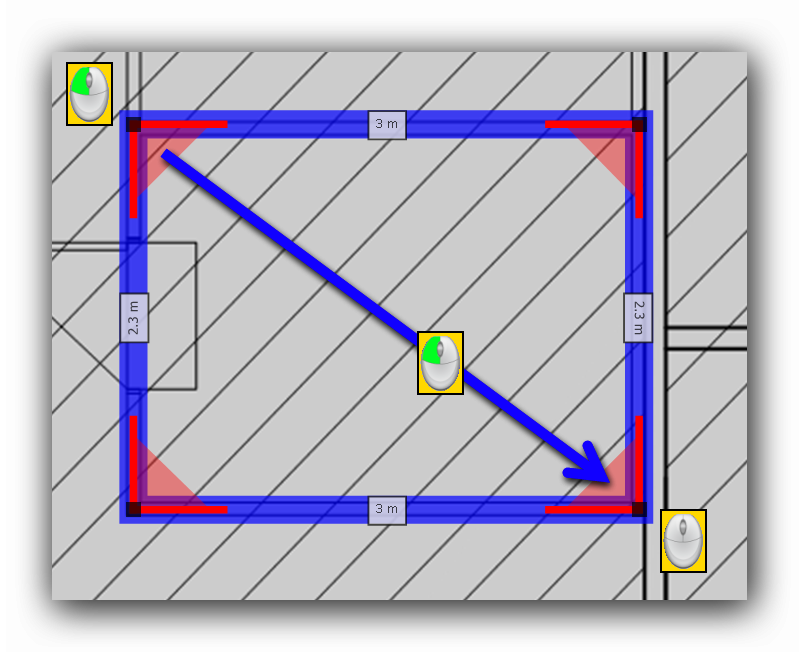
This method is preferred if the perimeter to be measured is square or rectangular. To measure a square or rectangular perimeter, click and hold the left mouse button down and stretch the shape to the opposite corner of the perimeter. Once the cursor is positioned on the opposite corner, release the left mouse button to complete the shape.
The Perimeter Tool's contextual menu
To access the contextual menu of the Perimeter tool, click on an handle anchor or a segment of the perimeter with the right button of the mouse. The menu will appear and display its many options.
The contextual menu will differ whether the user clicks on the perimeter or on an anchor point.
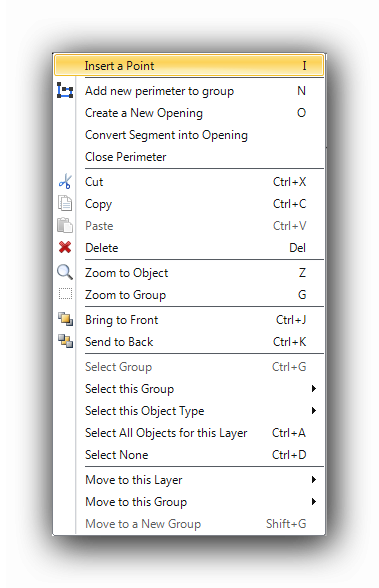
Insert a Point
This function insert an extra point on the Perimeter. This new point can then be moved to modify the shape of the Perimeter.
There are two (2) ways to apply Insert a Point when the focus is set on a Perimeter :
Delete this Point
This function deletes an point (anchor handle) on the Perimeter. The Perimeter will reshape itself to the two (2) adjacent points on each side of the deleted point.
There are two (2) ways to apply Delete this Point when the focus is set on a Perimeter :
Automatic Adjustment
The effects of the adjustment will operate on the segments that are near of the vertical or the horizontal by detecting these lines on the canvas and matching the area lines to these plan lines.
There are three (3) ways to apply Automatic Adjustment when the focus is set on a Perimeter :
Add a new perimeter to group
Adds a new Perimeter object to same group of the original Perimeter.
There are two (2) ways to apply Add a new perimeter to group when the focus is set on a Perimeter :
Create a New Opening
In a Perimeter, openings can be removed in portions of segments. For example : a wall length without its doors. The openings are performed in an existing perimeter segment.
There are two (2) ways to apply Create a New Opening when the focus is set on a Perimeter :
To Create a New Opening in a perimeter segment, position the cursor on the first point of the opening to create on the appropriate segment.
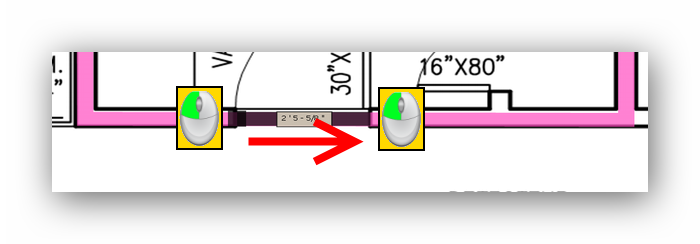
Then, click on the end point of the opening to release the tool. This will add two (2) anchor points on each side of the opening. The opening will show in a dotted line pattern. Many openings can be added in the same perimeter.

The Properties grid will display the global length result of the original Perimeter, the length of the opening(s), the length minus the openings and the quantity of openings.
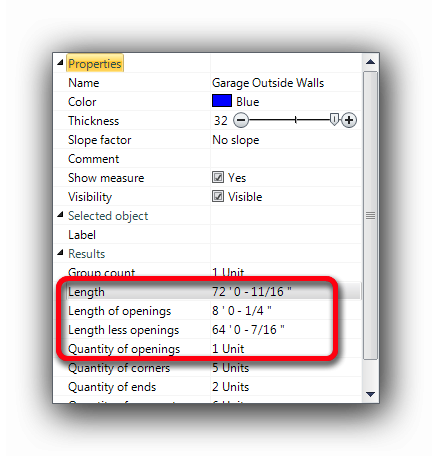
Apply a Height to an opening in a perimeter
When the perimeter tool is used along with an extension in order to get an area or volume result, the openings subtracted from a perimeter can be configured with a Height.
Once the opening drawn, the user can access the contextual menu by positioning the mouse cursor on the opening then right-click the mouse.
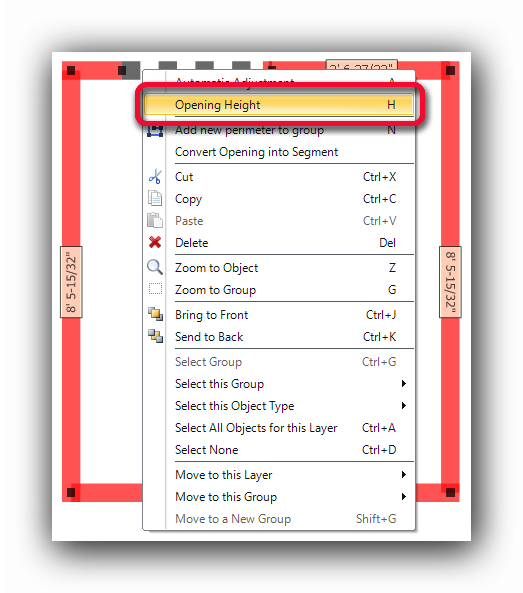
The "Opening Height" item appears in the contextual menu. The same effect can be obtained by using the (H) key on the keyboard, without accessing the contextual menu. Each individual opening can be configured with its own height. Clicking "Opening Height" or its keyboard equivalent (H) opens a popup which lets the user enter the opening height.
Hint :
When an opening is drawn in a perimeter, hold the Ctrl key while clicking the second point to automatically open the height popup, as shown below.
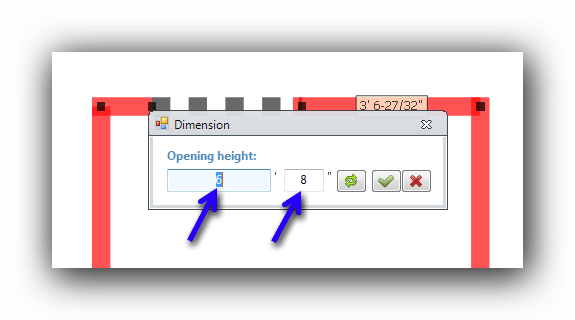
Once the height has been entered in the proper fields, click the green check button to validate the height. The "Conversion" button switches the measuring system to metric and back to Imperial.
switches the measuring system to metric and back to Imperial.
When the height is entered and validated, ProductName displays it on the opening on the canvas.
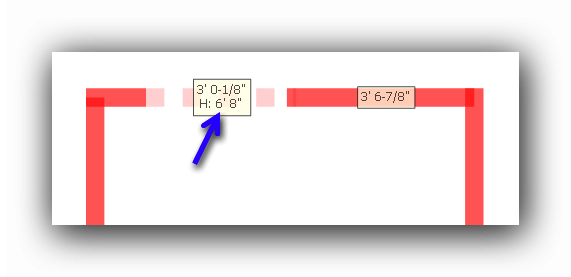
When using extensions along with the perimeter, the height value will be accounted for in area and volume calculations, depending on the nature of the extension chosen by the user.
Duplicating an opening in a perimeter (with or without height)
Once an opening is defined in a perimeter, it is possible to duplicate it many times in the same object group with the (D) key on the keyboard. The duplicated opening will inherit the values of the last opening defined by the user. To duplicate an opening, position the cursor on the perimeter itself and use the (D) key. On the horizontal or near horizontal segments or a perimeter, the duplicated opening will be generated at the right of the duplication point. On vertical or near vertical segments of a perimeter, the duplicated opening will be generated below the duplication point. Once the openings are created, it is still possible to readjust their position by moving their anchor points (on each side of the opening) on the perimeter segment.
Convert Segment into Opening and Convert Opening into Segment
The Convert Segment into Opening and Convert Opening into Segment functions modify the nature of a complete solid segment of a perimeter into an opening or vice versa. Position the cursor on the segment to be modified. If the segment is Converted into an Opening, it will show in a dotted line pattern. If the opening segment is Converted into a Segment, it will revert back to a solid pattern.
Insert a Rise / Drop
The Insert a Rise/Drop function is exclusive to the Perimeter tool. It allows the user to manually add dimensions in the "Z Axis" of the plan (the Depth not shown on the 2D plan). All dimensions entered in the Rises/Drops are added to the dimensions measured with the mouse.
To insert a Rise or Drop, position the mouse cursor on a perimeter line (choose the position of the rise/drop), then click the "R" key from the keyboard or right-click at the right position and select the "Insert Rise/Drop" item from the contextual menu.
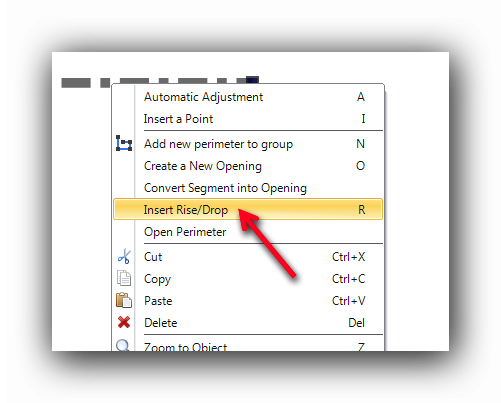
A dimension window appears to let the user enter the rise/drop length.
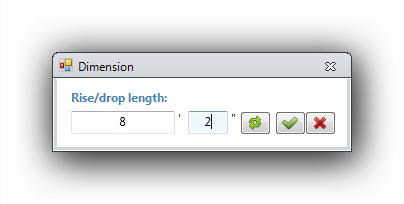
A rise/drop symbol will show on the perimeter line. An unlimited number of rises/drops can be added to any given perimeter.
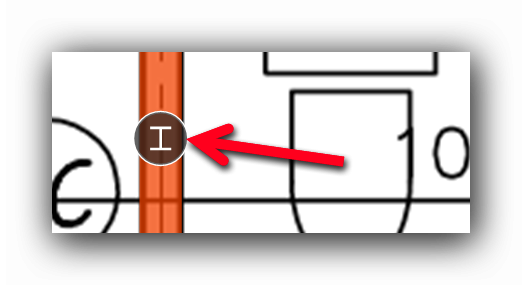
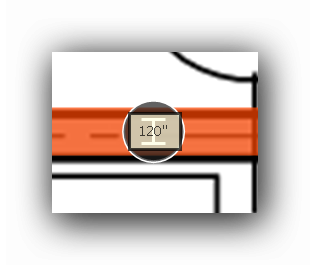
The dimensions of the rises/drops will be displayed and added to the overall dimension of the perimeter in the Properties panel.
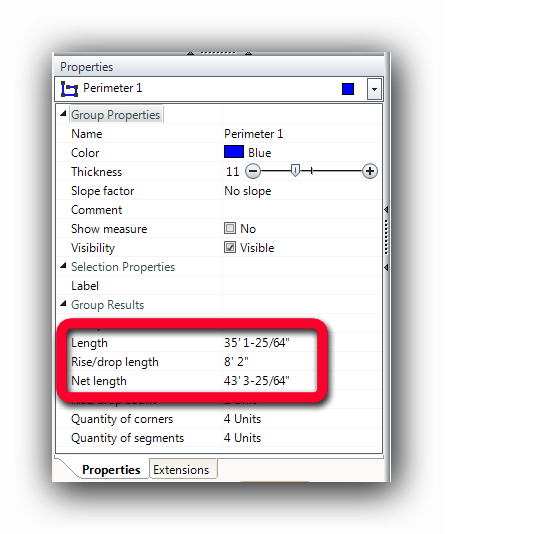
Once rises/drops are inserted, it is possible to modify their heights or to delete them.
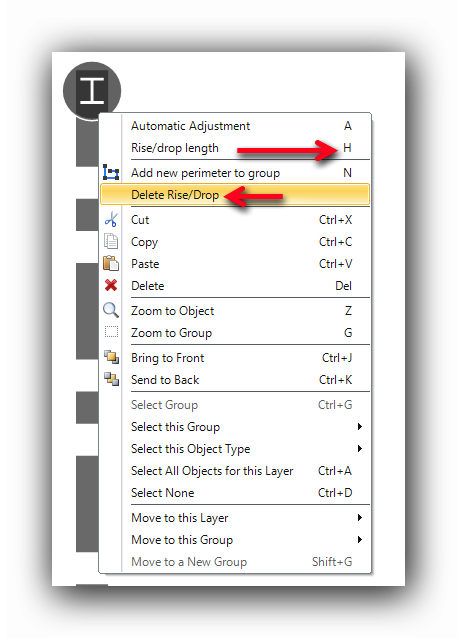
Open Perimeter and Close Perimeter
When a perimeter is not closed, i.e. the last segment does not join the original point, the Close Perimeter function will complete the missing segment to close the perimeter to the original point.
To open a closed perimeter, first click on the perimeter to be removed and use the Open Perimeter function.
For other functions of the contextual menu, click on the following topics :
Select Functions in Contextual Menus
Move Functions in Contextual Menus
Accurate move and positioning
To accurately move and position a Perimeter, use the arrows on the keyboard while holding the Ctrl button down. Many Perimeters can be moved simultaneously.
Pan the canvas while measuring.
The canvas can be panned while measuring with the Perimeter tool. Hold the right mouse button down and move the canvas. When the right mouse button is released, the canvas is repositioned and the measuring process continues.
See also :
Slope Factors with the Perimeter Tool